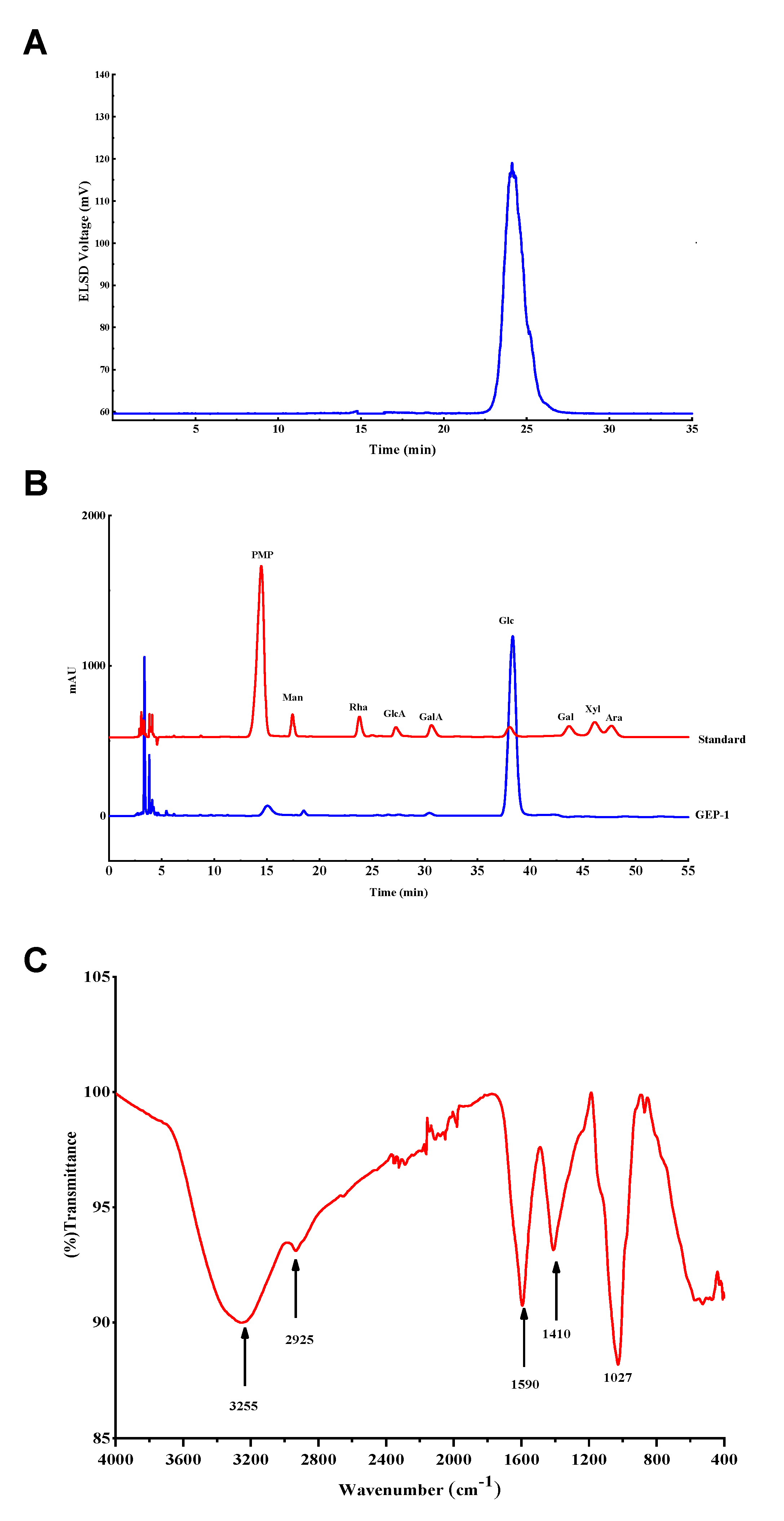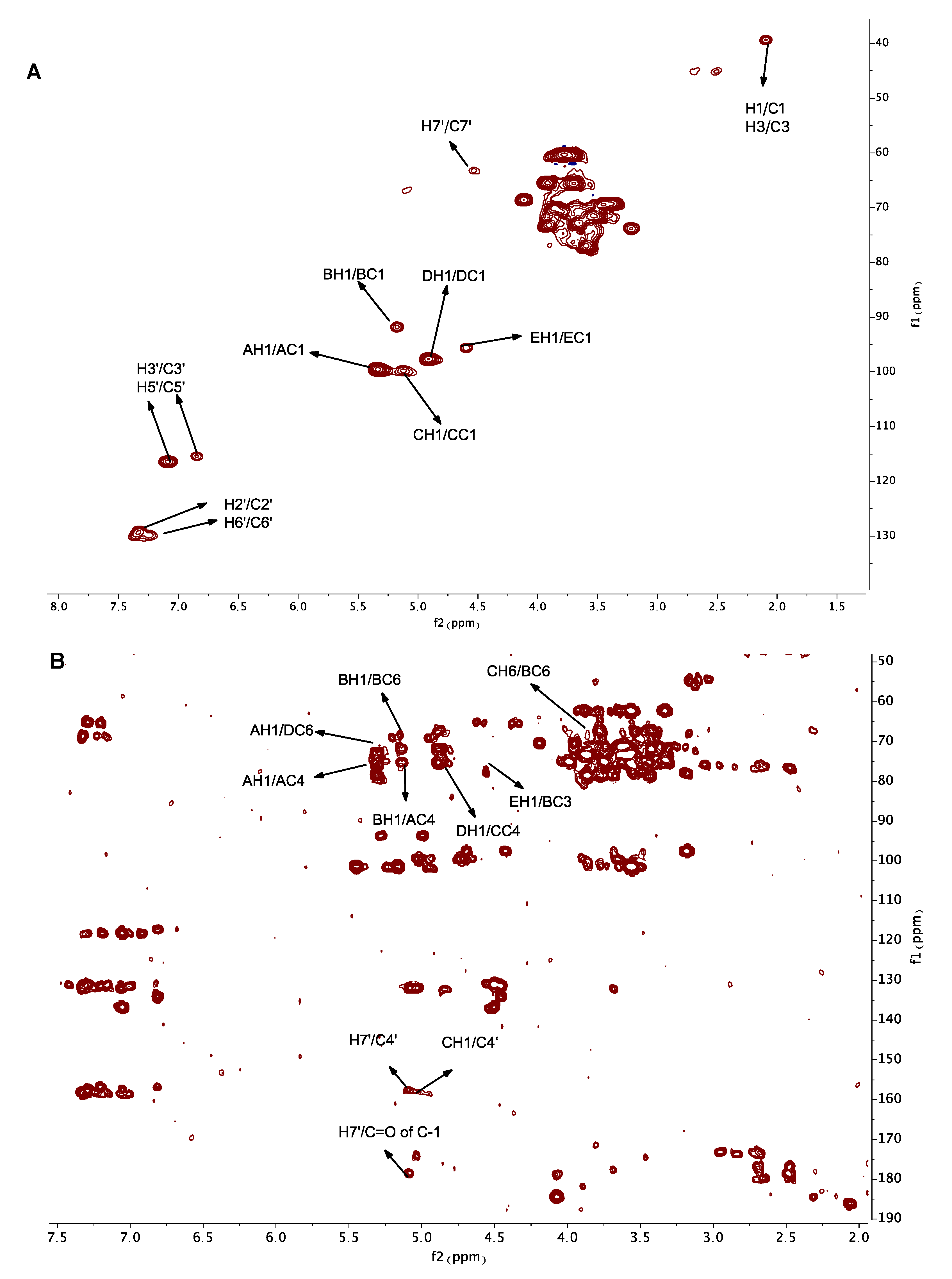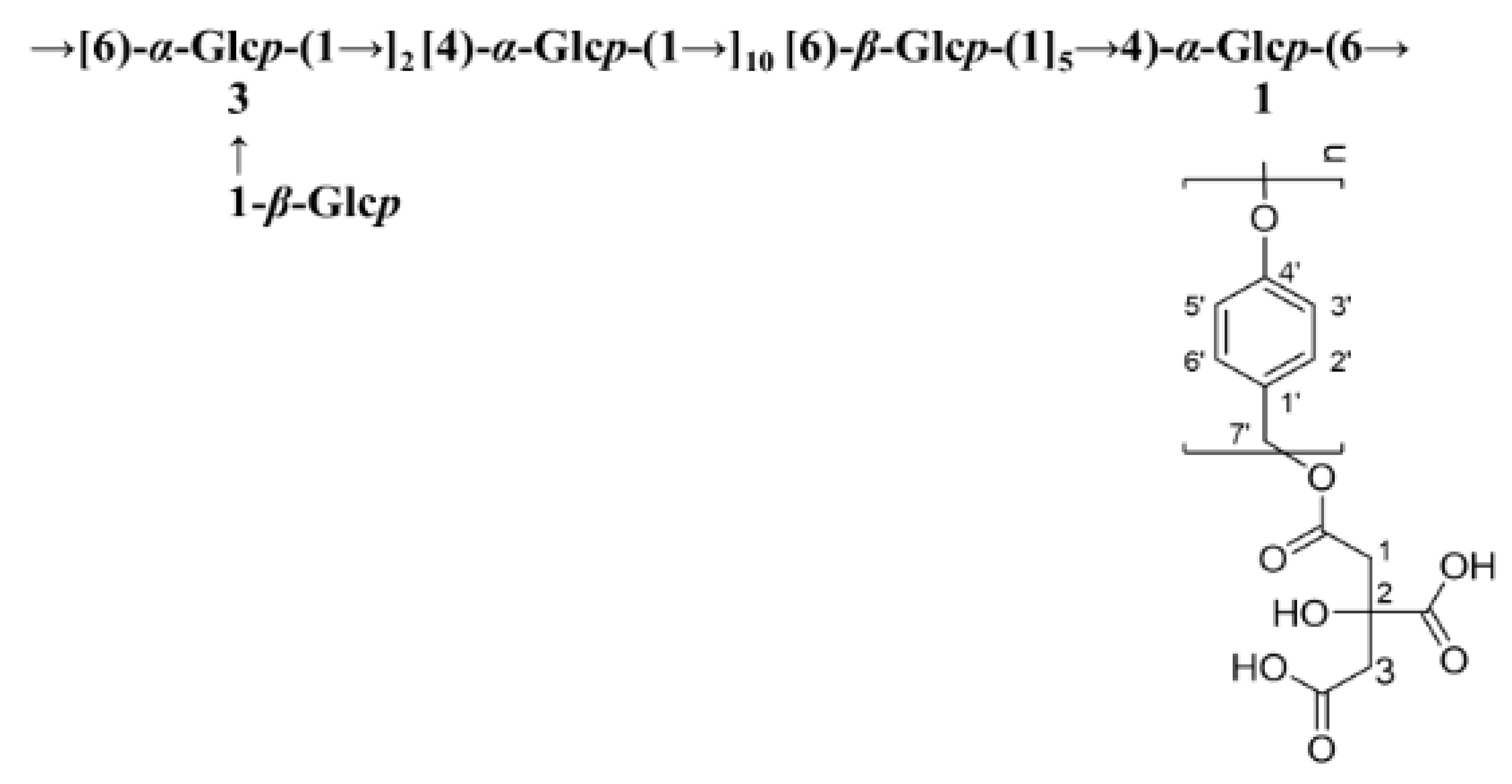Structural Characterization of a Polysaccharide from Gastrodia elata and Its Bioactivity on Gut Microbiota
Abstract
1. Introduction
2. Results and Discussion
2.1. Extraction, Isolation and Purification of GEP-1
2.2. Monosaccharide Composition, Linkage Pattern and CA and Repeated HA Analysis
2.3. FT-IR Analysis
2.4. NMR Analysis
2.5. SEM Analysis
2.6. GEP-1 Induced the Growth A. muciniphila and L. paracasei
3. Materials and Method
3.1. Materials
3.2. Extraction, Isolation and Purification of GEP-1
3.3. Estimation of Homogeneity and Molecular Weight
3.4. Analysis of Composition
3.5. Monosaccharide Composition
3.6. Fourier Transform Infrared (FT-IR) Spectroscopy
3.7. Methylation Analysis
3.8. NMR Analysis
3.9. Scanning Electron Microscopy (SEM) Analysis
3.10. Strains
4. Conclusions
Supplementary Materials
Author Contributions
Funding
Institutional Review Board Statement
Informed Consent Statement
Data Availability Statement
Conflicts of Interest
Sample Availability
References
- Shin, E.J.; Bach, J.-H.; Nguyen, T.T.L.; Jung, B.-D.; Oh, K.W.; Kim, M.J.; Jang, C.G.; Ali, S.F.; Ko, S.K.; Yang, C.H.; et al. Gastrodia elata Bl attenuates cocaine-induced conditioned place preference and convulsion, but not behavioral sensitization in mice: Importance of GABA(A) receptors. Curr. Neuropharmacol. 2010, 9, 26–29. [Google Scholar] [CrossRef]
- Hsieh, C.-L.; Chiang, S.-Y.; Cheng, K.-S.; Lin, Y.-H.; Tang, N.-Y.; Lee, C.-J.; Pon, C.-Z.; Hsieh, C.-T. Anticonvulsive and free radical scavenging activities of Gastrodia elata Bl. in kainic acid-treated rats. Am. J. Chin. Med. 2001, 29, 331–341. [Google Scholar] [CrossRef]
- Wu, C.R.; Hsieh, M.T.; Huang, S.C.; Peng, W.H.; Chang, Y.S.; Chen, C.F. Effects of Gastrodia elata and its active constituents on scopolamine-induced amnesia in rats. Planta Med. 1996, 62, 17–321. [Google Scholar] [CrossRef] [PubMed]
- Wang, Z.-W.; Li, Y.; Liu, D.-H.; Mu, Y.; Dong, H.-J.; Zhou, H.-L.; Guo, L.-P.; Wang, X. Four new phenolic constituents from the rhizomes of Gastrodia elata Blume. Nat. Prod. Res. 2018, 33, 1140–1146. [Google Scholar] [CrossRef]
- Liu, Z.-K.; Ng, C.-F.; Shiu, H.-T.; Wong, H.-L.; Chin, W.-C.; Zhang, J.-F.; Lam, P.-K.; Poon, W.-S.; Lau, C.B.-S.; Leung, P.-C.; et al. Neuroprotective effect of Da Chuanxiong Formula against cognitive and motor deficits in a rat controlled cortical impact model of traumatic brain injury. J. Ethnopharmacol. 2018, 217, 11–22. [Google Scholar] [CrossRef]
- Liu, J.; Mori, A. Antioxidant and free radical scavenging activities of Gastrodia elata Bl. and Uncaria rhynchophylla (Miq.) jacks. Neuropharmacology 1992, 31, 1287–1298. [Google Scholar] [CrossRef]
- Ha, J.H.; Shin, S.M.; Lee, S.K.; Kim, J.-S.; Shin, U.-S.; Huh, K.; Kim, J.-A.; Yong, C.-S.; Lee, N.-J.; Lee, D.-U. In vitro effects of hydroxybenzaldehydes from Gastrodia elata and their analogues on GABAergic neurotransmission, and a structureactivity correlation. Planta Med. 2001, 67, 877–880. [Google Scholar] [CrossRef]
- Ahn, E.K.; Jeon, H.J.; Lim, E.J.; Jung, H.J.; Park, E.H. Anti-inflammatory and anti-angiogenic activities of Gastrodia elata Blume. J. Ethnopharmacol. 2007, 110, 476–482. [Google Scholar] [CrossRef] [PubMed]
- Hu, K.; Jeong, J.H. A convergent synthetic study of biologically active benzofuran derivatives. Arch. Pharm. Res. 2006, 29, 476–478. [Google Scholar] [CrossRef] [PubMed]
- Choi, J.H.; Lee, D.U. A new citryl glycoside from Gastrodia elata and its inhibitory activity on GABA transaminase. Chem. Pharm. Bull. 2006, 54, 1720–1721. [Google Scholar] [CrossRef] [PubMed][Green Version]
- Matias, M.; Silvestre, S.; Falcão, A.; Alves, G. Gastrodia elata and epilepsy: Rationale and therapeutic potential. Phytomedicine 2016, 23, 1511–1526. [Google Scholar] [CrossRef] [PubMed]
- Hsieh, C.L.; Lin, J.J.; Chiang, S.Y.; Su, S.Y.; Tang, N.Y.; Lin, G.G.; Lin, I.H.; Liu, C.H.; Hsiang, C.Y.; Chen, J.C.; et al. Gastrodia elata modulated activator protein 1 via c-Jun N-terminal kinase signaling pathway in kainic acid-induced epilepsy in rats. J. Ethnopharmacol. 2007, 109, 241–247. [Google Scholar] [CrossRef]
- Zhao, Y.; Gong, X.J.; Zhou, X.; Kang, Z.J. Relative bioavailability of gastrodin and parishin from extract and powder of Gastrodiae rhizoma in rat. J. Pharm. Biomed. Anal. 2014, 100, 309–315. [Google Scholar] [CrossRef]
- Shu, C.H.; Qiao, N.; Piye, N.; Ming, W.H.; Xiao, S.S.; Feng, S.; Sheng, W.; Opler, M. Protective effects of Gastrodia elata on aluminium-chloride-induced learning impairments and alterations of amino acid neurotransmitter release in adult rats. Restor. Neurol. Neurosci. 2008, 26, 467–473. [Google Scholar]
- Liu, X.H.; Guo, X.N.; Zhan, J.P.; Xie, Z.L.; Wang, J.M.; Zhang, Y.T.; Chen, Y.L.; Li, X.B. The effects of polysaccharide from Gastrodia elata B1 on cell cycle and caspase proteins activity in H22 tumor bearing mice. Chin. J. Gerontol. 2015, 20, 5681–5682. [Google Scholar]
- Glisic, S.; Ivanovic, J.; Ristic, M.; Skala, D. Extraction of sage (Salvia officinalis L.) by supercritical CO2: Kinetic data, chemical composition and selectivity of diterpenes. J. Supercrit. Fluids 2010, 52, 62–70. [Google Scholar] [CrossRef]
- Chen, J.C.; Tian, S.; Shu, X.Y.; Du, H.T.; Li, N.; Wang, J.R. Extraction, characterization and immunological activity of polysaccharides from Rhizoma gastrodiae. Int. J. Mol. Sci. 2016, 17, 1011. [Google Scholar] [CrossRef]
- Zhou, B.H.; Tan, J.; Zhang, C.; Wu, Y. Neuroprotective effect of polysaccharides from Gastrodia elataume against corticosterone-induced apoptosis in PC12 cells via inhibition of the endoplasmic reticulum stress-mediated pathway. Mol. Med. Rep. 2018, 17, 1182–1190. [Google Scholar] [PubMed]
- Kim, K.J.; Lee, O.H.; Han, C.K.; Kim, Y.C.; Hong, H.D. Acidic Polysaccharide extracts from Gastrodia rhizomes suppress the atherosclerosis risk index through inhibition of the serum cholesterol composition in sprague dawley rats fed a high-fat diet. Int. J. Mol. Sci. 2012, 13, 1620–1631. [Google Scholar] [CrossRef]
- Xie, X.Y.; Chao, Y.M.; Du, Z.; Zhang, Y. Effects of polysaccharides from Gastrodia elata on anti-aging of ageing Mice. Pharm. J. Chin. PLA 2010, 26, 206–209. [Google Scholar]
- Li, H.B.; Wu, F.; Miao, H.C.; Xiong, K.R. Effects of polysaccharide of Gastrodia elataume and electro-acupuncture on expressions of brain-derived neurotrophic factor and stem cell factor protein in caudate putamen of focal cerebral ischemia rats. Med. Sci. Monit. Basic. Res. 2016, 22, 175–180. [Google Scholar] [CrossRef]
- Liu, H.; Zhang, M.; Ma, Q.; Tian, B.; Nie, C.; Chen, Z.; Li, J. Health beneficial effects of resistant starch on diabetes and obesityviaregulation of gut microbiota: A review. Food Funct. 2020, 11, 5749–5767. [Google Scholar] [CrossRef] [PubMed]
- Koropatkin, N.M.; Cameron, E.A.; Martens, E.C. How glycan metabolism shapes the human gut microbiota. Nat. Rev. Microbiol. 2012, 10, 323–335. [Google Scholar] [CrossRef] [PubMed]
- Wang, K.; Yang, X.; Wu, Z.; Wang, H.; Li, Q.; Mei, H.; You, R.; Zhang, Y. Dendrobium officinale polysaccharide protected CCl4-induced liver fibrosis through intestinal homeostasis and the LPS-TLR4-NF-kappa B signaling pathway. Front. Pharmacol. 2020, 11, 240. [Google Scholar] [CrossRef] [PubMed]
- Chang, C.-J.; Lin, C.-S.; Lu, C.-C.; Martel, J.; Ko, Y.-F.; Djcius, D.M.; Tseng, S.-F.; Wu, T.-R.; Chen, Y.-Y.M.; Young, J.D.; et al. Ganoderma lucidum reduces obesity in mice by modulating the composition of the gut microbiota. Nat. Commun. 2015, 6, 7489. [Google Scholar] [CrossRef] [PubMed]
- Ding, Y.; Yan, Y.M.; Chen, D.; Ran, L.; Mi, J.; Lu, L.; Jing, B.; Li, X.; Zeng, X.; Cao, Y. Modulating effects of polysaccharides from the fruits of Lycium barbarum on the immune response and gut microbiota in cyclophosphamide-treated mice. Food Funct. 2019, 10, 3671–3683. [Google Scholar] [CrossRef] [PubMed]
- Zhang, R.; Yuan, S.; Ye, J.; Wang, X.; Zhang, X.; Shen, J.; Yuan, M.; Liao, M. Polysaccharide from flammuliana velutipes improves colitis via regulation of colonic microbial dysbiosis and inflammatory responses. Int. J. Biol. Macromol. 2005, 149, 1252–1261. [Google Scholar] [CrossRef]
- Lai, C.-J.-S.; Yuan, Y.; Liu, D.-H.; Kang, C.-Z.; Zhang, Y.; Zha, L.; Kang, L.; Chen, T.; Nan, T.-G.; Hao, Q.-X.; et al. Untargeted metabolite analysis-based UHPLC-Q-TOF-MS reveals significant enrichment of p-hydroxybenzyl dimers of citric acids in fresh beige-scape Gastrodia elata (Wutianma). J. Pharm. Biomed. 2017, 140, 287–294. [Google Scholar] [CrossRef]
- Zhan, H.-D.; Zhou, H.-Y.; Sui, Y.-P.; Du, X.-L.; Wang, W.; Dai, L.; Sui, F.; Huo, H.-R.; Jiang, T.-L. The rhizome of Gastrodia elata Blume—An ethnopharmacological review. J. Ethnopharmacol. 2016, 189, 361–385. [Google Scholar] [CrossRef]
- Wang, Y.W.; Li, Z.F.; He, M.Z.; Feng, Y.L.; Wang, Q.; Li, X.; Yang, S.L. Chemical constituents of Gastrodia elata. Chin. Tradit. Herbal Drugs 2013, 44, 2974–2976. [Google Scholar]
- Zhu, H.; Liu, C.; Hou, J.; Long, H.; Wang, B.; Guo, D.; Lei, M.; Wu, W. Gastrodia elata Blume polysaccharides: A review of their acquisition, analysis, modification, and pharmacological activities. Molecules 2019, 24, 2436. [Google Scholar] [CrossRef]
- Chang, Y.; Lu, W.; Chu, Y.; Yan, J.K.; Wang, S.J.; Xu, H.X.; Ma, H.L. Extraction of polysaccharide from maca: Characterization and immunoregulatory effects on CD4+ T cell. Int. J. Biol. Macromol. 2020, 154, 477–485. [Google Scholar] [CrossRef] [PubMed]
- Huo, J.Y.; Lu, Y.; Jiao, Y.K.; Chen, D.F. Structural characterization and anticomplement activity of an acidic polysaccharide from Hedyotis diffusa. Int. J. Biol. Macromol. 2020, 155, 1553–1560. [Google Scholar] [CrossRef] [PubMed]
- Hakomori, S. A rapid premethylation of glycolipid and polysaccharide catalyzed methysufinyl carbanion in dimethyl sulfoxide. J. Biochem. 1964, 55, 205–208. [Google Scholar] [PubMed]
- Lin, Z.; Li, T.; Yu, Q.; Chen, H.; Zhou, D.; Li, N.; Chunyan Yan, C. Structural characterization and in vitro osteogenic activity of ABPB-4, a heteropolysaccharide from the rhizome of Achyranthes bidentata. Carbohyd. Polym. 2021, 259, 117553. [Google Scholar] [CrossRef]





| Methylated Sugars | Linkages | Major Mass Fragments (m/z) | Molar Ratio |
|---|---|---|---|
| 2,3,4,6-Me4-Glc | 1-linked-Glc | 43, 71, 87, 102, 118, 129, 145, 161, 162, 205 | 2.23 |
| 2,3,6-Me3-Glc | 1,4-linked-Glc | 43, 59, 71, 87, 102, 118, 129, 162, 233 | 9.69 |
| 2,3,4-Me3-Glc | 1,6-linked-Glc | 43, 59, 87, 99, 101, 118, 129, 162, 189, 233 | 4.93 |
| 2,3-Me2-Glc | 1,4,6-linked-Glc | 43, 59, 85, 102, 118, 127, 162, 201, 161 | 1.08 |
| 2,6-Me2-Glc | 1,3,4-linked-Glc | 43, 59, 87, 118, 129, 160, 185, 305 | 2.07 |
| Name | Molecular Formula | Theoric Mass | tR (min) | m/z Experimental | pos/neg | Error (ppm) |
|---|---|---|---|---|---|---|
| CA | C6H8O7 | 192.0265 | 2.72 | 193.0343 | [M + H]+ | −0.047 |
| 1HA | C7H8O2 | 124.0519 | 1.12 | 107.0489 | [M − H2O + H]+ | −2.535 |
| 2HA | C14H14O3 | 230.0937 | 8.44 | 213.0913 | [M − H2O + H]+ | 1.473 |
| 3HA | C21H20O4 | 336.1356 | 8.86 | 319.1326 | [M − H2O + H]+ | -0.894 |
| 4HA | C28H26O5 | 442.1775 | 9.16 | 425.1745 | [M − H2O + H]+ | −0.554 |
| 5HA | C35H32O6 | 548.2193 | 9.40 | 531.2161 | [M − H2O + H]+ | −1.018 |
| 6HA | C42H38O7 | 654.2612 | 9.52 | 637.2576 | [M − H2O + H]+ | −1.311 |
| 7HA | C49H44O8 | 760.3031 | 9.58 | 743.3001 | [M − H2O + H]+ | −0.377 |
| Glc | C6H12O6 | 180.0628 | 1.02 | 163.0597 | [M − H2O + H]+ | −2.207 |
| CA | C6H8O7 | 192.0265 | 2.75 | 191.0196 | [M − H]− | 5.293 |
| Glc | C6H12O6 | 180.0628 | 1.02 | 179.0561 | [M − H]− | 0.160 |
| 1HA | C7H8O2 | 124.0519 | 1.12 | 105.0349 | [M − H2O + H]− | 2.493 |
| 2HA | C14H14O3 | 230.0937 | 8.44 | 211.0766 | [M − H2O − H]− | 0.839 |
| 3HA | C21H20O4 | 336.1356 | 8.92 | 317.1182 | [M − H2O − H]− | −0.403 |
| 4HA | C28H26O5 | 442.1775 | 9.16 | 423.1605 | [M − H2O − H]− | 0.656 |
| 4HA | C28H26O5 | 442.1775 | 9.16 | 411.1606 | [M − CH2O − H]− | 1.113 |
| 5HA | C35H32O6 | 548.2193 | 9.13 | 529.2029 | [M − H2O − H]− | 1.681 |
| 6HA | C42H38O7 | 654.2612 | 9.38 | 635.2458 | [M − H2O − H]− | 2.956 |
| 7HA | C49H44O8 | 760.3031 | 9.49 | 741.2882 | [M − H2O − H]−- | 3.201 |
| 8HA | C56H50O9 | 866.3449 | 9.73 | 847.3228 | [M − H2O − H]− | 0.140 |
| 9HA | C63H56O10 | 972.2868 | 9.76 | 953.3691 | [M − H2O − H]− | −0.447 |
| 10HA | C70H62O11 | 1078.4287 | 9.85 | 1047.4118 | [M − CH2O − H]− | 0.476 |
| 10HA | C70H62O11 | 1078.4287 | 9.85 | 1059.4114 | [M − H2O − H]− | 0.008 |
| Code | Residues | Chemical Shifts (ppm) | |||||
|---|---|---|---|---|---|---|---|
| H1/C1 | H2/C2 | H3/C3 | H4/C4 | H5/C5 | H6/C6 | ||
| A | ⟶4)-α-Glcp-(1⟶ | 5.33/99.67 | 3.56/73.15 | 3.89/74.93 | 3.89/73.37 | 3.89/74.93 | 3.70/61.87 |
| B | ⟶3,6)-α-Glcp-(1⟶ | 5.18/91.93 | 3.64/73.0 | 3.76/76.34 | 3.39/71.67 | 3.81/71.91 | 3.63/67.21 |
| C | ⟶4,6)-α-Glcp-(1⟶ | 5.10/100.00 | 3.58/73.42 | 3.90/74.93 | 3.67/74.33 | 3.83/71.78 | 3.90/66.07 |
| D | ⟶6)-β-Glcp-(1⟶ | 4.91/97.90 | 3.38/76.4 | 3.63/77.4 | 3.45/72.6 | 3.63/77.7 | 3.74/68.76 |
| E | β-Glcp-(1⟶ | 4.60/95.73 | 3.19/73.96 | 3.72/72.89 | 3.34/69.37 | 3.55/74.57 | 3.85/60.52 |
Publisher’s Note: MDPI stays neutral with regard to jurisdictional claims in published maps and institutional affiliations. |
© 2021 by the authors. Licensee MDPI, Basel, Switzerland. This article is an open access article distributed under the terms and conditions of the Creative Commons Attribution (CC BY) license (https://creativecommons.org/licenses/by/4.0/).
Share and Cite
Huo, J.; Lei, M.; Li, F.; Hou, J.; Zhang, Z.; Long, H.; Zhong, X.; Liu, Y.; Xie, C.; Wu, W. Structural Characterization of a Polysaccharide from Gastrodia elata and Its Bioactivity on Gut Microbiota. Molecules 2021, 26, 4443. https://doi.org/10.3390/molecules26154443
Huo J, Lei M, Li F, Hou J, Zhang Z, Long H, Zhong X, Liu Y, Xie C, Wu W. Structural Characterization of a Polysaccharide from Gastrodia elata and Its Bioactivity on Gut Microbiota. Molecules. 2021; 26(15):4443. https://doi.org/10.3390/molecules26154443
Chicago/Turabian StyleHuo, Jiangyan, Min Lei, Feifei Li, Jinjun Hou, Zijia Zhang, Huali Long, Xianchun Zhong, Yameng Liu, Cen Xie, and Wanying Wu. 2021. "Structural Characterization of a Polysaccharide from Gastrodia elata and Its Bioactivity on Gut Microbiota" Molecules 26, no. 15: 4443. https://doi.org/10.3390/molecules26154443
APA StyleHuo, J., Lei, M., Li, F., Hou, J., Zhang, Z., Long, H., Zhong, X., Liu, Y., Xie, C., & Wu, W. (2021). Structural Characterization of a Polysaccharide from Gastrodia elata and Its Bioactivity on Gut Microbiota. Molecules, 26(15), 4443. https://doi.org/10.3390/molecules26154443






